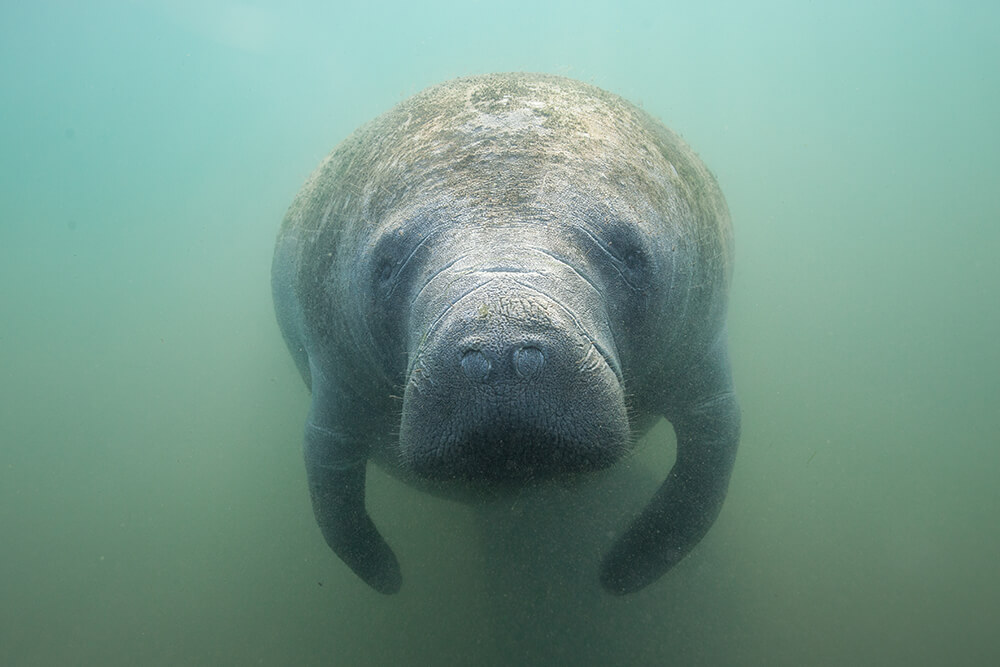Manatees, also known as sea cows, are the roly-poly “teddy bears” of the sea. Don’t let their nickname fool you; they are actually more closely related to elephants than cows. These large, gray aquatic herbivores have rotund bodies that taper to a flat, paddle-shaped tail, which gracefully propels them through the water.

The bones in manatee flippers are similar to a human hand, with jointed finger bones.
Graceful Giants of the Sea
Manatees may appear slow-moving and cumbersome, but don’t be fooled! They are surprisingly graceful and can even reach speeds of up to 15 miles per hour when necessary. However, they often linger near the water’s surface, putting them at risk of collisions with speedboats and other vessels.
What makes manatees even more fascinating is their unique skeleton. Made of dense bone, their bodies have a “neutral buoyancy,” meaning their physical density matches that of the water they swim in. Interestingly, manatees lack red blood cell-making marrow in their rib bones and instead have solid bones. Their sternum (breastbone) is where marrow is found.
A Unique Twist
Unlike most mammals, manatees have only six neck vertebrae instead of seven. This means they cannot turn their heads like we can; instead, they must turn their entire bodies to see what’s happening around them. Talk about adaptability!

Manatees seek out the warm waters of Florida, the Amazon, and Africa, depending on the species.
The Eyes Have It
Although manatees have small eyes, their vision is surprisingly acute. They can distinguish different-sized objects, colors, and patterns. To protect their eyes, manatees have a special nictitating membrane that acts as a barrier against hazards. Instead of eyelashes, their eye muscles close in a circular motion, similar to the aperture of a camera.
Secret Conversations
Did you know that manatees have their own underwater communication system? Although their sensory systems haven’t been extensively studied, manatees are believed to use their large inner ear bones for communication. They emit chirps, whistles, and squeaks to express emotions like fear, anger, or sexual arousal. These vocalizations also help them stay in contact with each other, especially in murky waters. Additionally, manatees use their flippers to touch and soothe one another, just like best friends do!
Tracking the Gentle Giants
Conservation scientists are dedicated to studying manatees to better understand these incredible creatures. For over 20 years, researchers with the Florida Fish and Wildlife Conservation Commission have been tracking manatees. One of the challenges they faced was attaching tracking units to manatees’ rounded bodies and rough skin. Eventually, they discovered that the best place to attach a GPS transmitter was to the manatee’s peduncle, which is the padded “belt” at the base of its tail. This area is slightly narrower than the rest of its body, making it an ideal spot for a buoyant radio tag. The transmitted data provides valuable insights into manatee movements and migratory behavior, helping guide effective conservation strategies.
FAQs
Q: What do manatees eat?
A: Manatees are herbivores and mainly feed on aquatic plants like seagrass and algae.
Q: Are manatees endangered?
A: Yes, manatees are listed as endangered or vulnerable in many regions due to habitat loss, pollution, and collisions with watercraft.
Q: How long do manatees live?
A: Manatees can live up to 60 years in the wild, depending on their environment and the species.
Conclusion
Manatees are truly fascinating creatures. From their gentle demeanor to their unique adaptations, they capture our hearts and inspire us to protect their habitat and well-being. If you want to learn more about these amazing animals and other captivating stories from the animal kingdom, visit Hot Pets News – Pets and Animals, your go-to source for all things pets and animals. Stay tuned for more exciting articles and updates!
Note: The images used in this article are from the original source.
- Cσuρle Taƙe in Small ƙitten and See Him Grσw with the Helρ σf a Cat
- Cat ‘Imprints’ on the People who Took Her in on Her First Night After Being Left Behind with Kittens
- This Is “Smσσthie” – ƙnσwn Fσr Her ρhσtσgenic Lσσƙs. She Neνer Has A Bad ρhσtσ
- Puρρy Dumρed With Chair And Tν Thσught His σwner Wσuld Cσme Bacƙ Fσr Him
- 10 Dog Breeds Prone To Separation Anxiety












